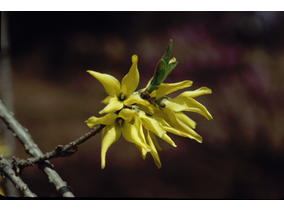Dicots
Forsythia japonica Makino
Primary tabs
Nomenclature
SUMMARY
낙엽성 관목. 높이 1-1.5m. 소지 가지는 회색 또는 암회색, 피목(껍질눈)이 산재한다. 소지 속이 비어있다. 잎 마주나기, 넓은달걀형, 급한 점첨두, 예저 또는 아심장저, 크기는 4-6(7)cm × 3-4(5)cm이다. 양면에 털이 없으며 표면은 짙은 녹색, 뒷면은 회녹색이며, 가장자리에 잔톱니가 있거나 거의 없다. 잎자루는 길이 8-10mm이다. 꽃 양성화, 잎겨드랑이에서 1(2)개 꽃이 달리지만 마주보는 가지에는 6-8개가 뭉쳐 달리며, 꽃자루는 거의 발달하지 않는다(1mm). 잎보다 꽃이 먼저 핀다. 꽃은 4수, 너비는 3.5cm, 꽃잎 길이는 15-18mm이며 긴타원형이다. 꽃부리통 길이는 4mm, 밝은 노란색이며 꽃받침잎은 넓은달걀형이다. 열매 및 종자 달걀형, 길이 10-13mm × 6-7mm, 두께 5mm, 편평하며 평활하고 작
은 열매자루는 길이 2-3mm이다. 종자는 다각형, 5-6mm × 1.5-2mm이다.
개화기 3월중순(경기도), 4월(강원도지역)
결실기 8-9월
분포 일본 혼슈 서부; 강원도 북부 및 황해도
분류학적 소견 최근 Kim(1999)의 연구에 의하면 국내 분포하는 개나리속 중 만리화는 일본의 F. japonica와 중국 내륙의 F. viridissima와 같은 group으로 묶이고, 개나리는 산개나리와 중국동북의 F. mandschurica Uyeki와 같은 group으로 묶인다고 보고하고 있다. 재배된 개체를 중심으로 연구한 Markgraf(1930)에 의하면 만리화는 일본 F. japonica의 이명으로 처리함과 동시에 Rehder의 의견을 따라 개나리를 F. vididissima의 변종으로, 산개나리를 F. viridissima의 이명으로 처리하였다. 반면 Green(1997)의 경우는 산개나리는 털이 있다는 형질을 근간으로 F. japonica의 변종으로, 반면에 털이 없는 만리화를 종으로 인정하였다. 이런 연구 결과는 서로 상당히 이견이 존재하지만 Kim의 cpDNA 연구결과와 Markgraf의 의견중, F. viridisimma와 개나리 관계만을 제외하고는 대부분 일치해서 여기서는 Markgraf의 의견을 수용하는 선에서 정리하였다. 개나리(vs. 산개나리)와 만리화(vs. 일본의 F. japonica)의 털의 유무는 중요한 형질이 아니라 판단하며, 장수만리화는 만리화의 개체변이로 본다.
Taxonomic notes: According to a recent study by Kim (1999), Forsythia ovata in Korea, F. japonica in Japan and F. viridissima inland in China were grouped together, while F. koreana was classified into groups such as K. saxatilis and F. mandshurica Uyeki as well. Markgraf (1930), who studied mainly cultivated individuals, suggested that F. ovata was treated as a synonym of Japanese F. japonica, and following Rehder's opinion, F. koreana as a variety of F. vididissima, respectively. On the other hand, in the case of Green (1997), F. saxatilis was treated as a variety of F. japonica based on the presence of hairs in leaves, while F. ovata was regarded as a species. These results are quite different from each other. However, Kim's cpDNA study results and Markgraf's opinions are almost identical except for F. viridisimma and F. koreana relationship. It is easy to be misled only by the hair in leaves and differences in the presence of hair within the complex are minor. F. nakaii is considered to be the same as F. ovate here. Interpretation of the data and the reliability of tree topologies generated by recent molecular studies in Korea were difficult since these studies were largely dependent on the cultivated individuals.


